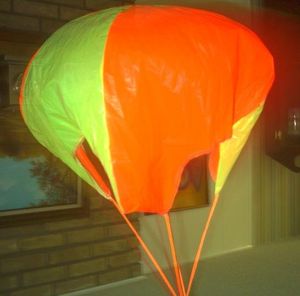| Construction Rating: | starstarstarstarstar_border |
| Flight Rating: | starstarstarstarstar |
| Overall Rating: | starstarstarstarstar |
Brief:
The Covert Rocketry High Tech chute is a 13", 4 panel, 4 shroud parachute
made of ripstop nylon.

Construction:
I was invited to test some High Tech Chutes parachutes for a new manufacturer
Covert Rocketry. I'm glad I did
this as I am sincerely impressed. I actually received two of their chute, the
CR-3 and CR-4. I tested only the former, rated at 1 to 2 lbs (13 to 18 fps
descent).
The material used is very slick, almost like it's oiled. It was obvious the chute would have less problems getting stuck in the body than others. The chute is very well sewn. The shrouds are thicker than any others I've used for the chute size since there are only 4. As you can see from the picture, it's a 4 panel spherical chute. Laid flat it's about 18" between opposing shrouds. Inflated, it's about 13".
This is similar in design to a 24" TAC-1 chute I have but a lot lighter. By comparison, the TAC-1 is built like a high speed drogue, shrouds rated at 1400 lbs and swivel at 1500. The 24" version has a descent rating of 17 fps for 1 pound weight. It weighs 5.4 oz. The CR-3 weighs less than 2, with a similar swivel.
Construction Rating: 4 out of 5
Flight:
To give you an idea of how small these chutes pack, the two I received
(13" and 18" models) and their relatively heavy (canvas?) deployment
bags were packed into a box 3/4" x 4" x 6". With some careful
maneuvering I was able to fit the CR-3 into a 29mm body and easily blow it out
by blowing on the other end.
Recovery:
I put it up in my 2.5lb LOC Vulcanite on a G40-7. The sim had it ejecting at 26
fps, 0.8 sec. before apogee. The wind was 7-8mph on the ground and by previous
flights was about twice that speed at altitude. Ejection was as predicted, just
prior to horizontal. Chute inflation was almost instantaneous and the
fluorescent red-orange and chartruse panels were very visible against the
overcast sky. There was no spinning and very little rocking. The rocket hung
nearly straight down the entire way. The descent had clearly less drift than
the other flights of the day.
We've all seen flights where people commented on how well the boost went. I've never before had comments on how well the descent went and I had not mentioned before the flight that I was testing a new chute. As it landed, it was clearly coming down a bit fast, maybe 20-22 fps, but I was after all stressing it by testing it heavier than its rating. Upon retrieval, no shrouds were tangled, despite having used no swivel. Close examination later revealed two small threads hanging loose near one of the shrouds. At first I thought there was some unraveling. But it turned out to be only excess thread from the sewing. Pulling on the panels didn't cause any unraveling.
I generally favor X-form chutes for keeping drift to a minimum. Unfortunately if they are unbalanced they tend to rock and spin a fair amount so that if a swivel isn't used will cause severe winding of the shrouds (tightening the opening) and/or winding of the shock cord. And when I use them I leave the shrouds loose to slide through the quick-link to try to keep them self-balancing. The shrouds on the CR-3 came knotted and I left them that way. After getting it home I checked it, and it was unbalanced by about half an inch. The CR-3 had at least as much drift reduction as the 24" X-form I've previously used on this rocket and none of the spinning or tangling.
Flight Rating: 5 out of 5
Summary:
When these were first announced I thought the original MSRP was a bit high.
Now, I don't think so. $15.00 for something weight rated equal to and more than
the TAC-1 (at $20) is a good price. The TAC-1 might be able to handle a higher
speed deployment but I suspect that the speed where the TAC-1 would survive
high speed deployment where the CR-3 would not survive, however, there would
more than likely be a zipper or other airframe damage.
Overall Rating: 5 out of 5
 |
 |